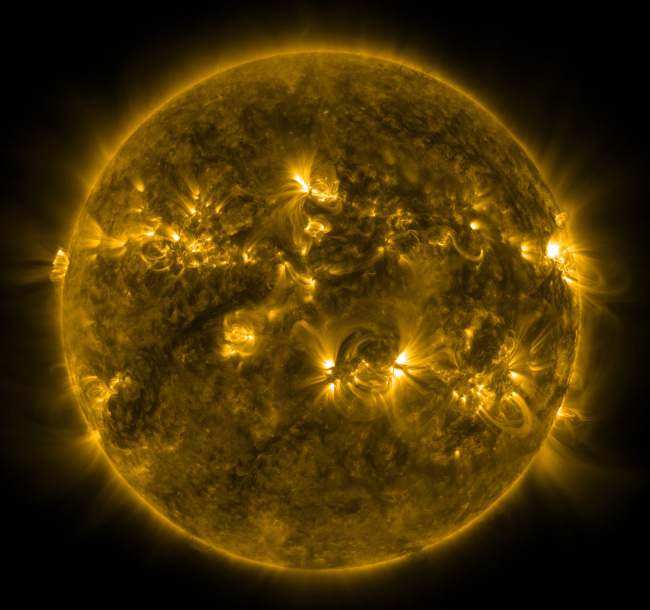Calm solar cycle prompts questions about Earth impact
By Korea HeraldPublished : Nov. 27, 2013 - 19:39

WASHINGTON (AFP) ― The surface of the sun has been surprisingly calm of late ― with fewer sunspots than anytime in the last century ― prompting curious scientists to wonder just what it might mean here on Earth.
Sunspots have been observed for millennia ― first by Chinese astronomers and then, for the first time with a telescope, by Galileo in 1610.
The sunspots appear in roughly 11-year cycles ― increasing to a daily flurry and then subsiding drastically, before amping up again.
But this cycle ― dubbed cycle 24 ― has surprised scientists with its sluggishness.
The number of spots counted since it kicked off in December 2008 is well below the average observed over the last 250 years. In fact, it’s less than half.
“It is the weakest cycle the sun has been in for all the space age, for 50 years,” National Oceanic and Atmospheric Association physicist Doug Biesecker told AFP.
The intense electromagnetic energy from sunspots has a significant impact on the sun’s ultraviolet and X-ray emissions as well as on solar storms.
Solar storms can interrupt telecommunications and electronic networks on Earth. Sunspot activity can also have an impact on the Earth’s climate.
Cycle 23 hit its maximum in April 2000 with an average of 120 solar spots a day.
The cycle then wound down, hitting bottom around December 2008, the point at which scientists marked the start of the current cycle.
The minimal solar activity at the end of cycle 23 led astronomers to predict a slow cycle 24. But the reality fell even below expectations.
In the first year of the cycle, during which solar activity should have risen, astronomers counted 266 days without a single sunspot.
“The forecast peak was 90 sunspots,” Biesecker said, noting that even though the activity has risen over the past year, “it’s very clear it is not going to be close to 90.”
“The sunspots number peaked last year at 67, almost half a typical cycle,” he added.
The last time a sunspot cycle was this slow was in February 1906, the peak of cycle 14, with just 64 spots a day.
The “very long minimum: three years, three times more than the previous three cycles of the space age” was a major surprise, said University of Montana physicist Andres Munoz-Jamillio.
Sunspots have been observed for millennia ― first by Chinese astronomers and then, for the first time with a telescope, by Galileo in 1610.
The sunspots appear in roughly 11-year cycles ― increasing to a daily flurry and then subsiding drastically, before amping up again.
But this cycle ― dubbed cycle 24 ― has surprised scientists with its sluggishness.
The number of spots counted since it kicked off in December 2008 is well below the average observed over the last 250 years. In fact, it’s less than half.
“It is the weakest cycle the sun has been in for all the space age, for 50 years,” National Oceanic and Atmospheric Association physicist Doug Biesecker told AFP.
The intense electromagnetic energy from sunspots has a significant impact on the sun’s ultraviolet and X-ray emissions as well as on solar storms.
Solar storms can interrupt telecommunications and electronic networks on Earth. Sunspot activity can also have an impact on the Earth’s climate.
Cycle 23 hit its maximum in April 2000 with an average of 120 solar spots a day.
The cycle then wound down, hitting bottom around December 2008, the point at which scientists marked the start of the current cycle.
The minimal solar activity at the end of cycle 23 led astronomers to predict a slow cycle 24. But the reality fell even below expectations.
In the first year of the cycle, during which solar activity should have risen, astronomers counted 266 days without a single sunspot.
“The forecast peak was 90 sunspots,” Biesecker said, noting that even though the activity has risen over the past year, “it’s very clear it is not going to be close to 90.”
“The sunspots number peaked last year at 67, almost half a typical cycle,” he added.
The last time a sunspot cycle was this slow was in February 1906, the peak of cycle 14, with just 64 spots a day.
The “very long minimum: three years, three times more than the previous three cycles of the space age” was a major surprise, said University of Montana physicist Andres Munoz-Jamillio.
-
Articles by Korea Herald



















